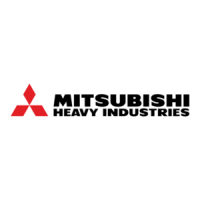
Do you have a question about the Mitsubishi Heavy Industries HSB140 and is the answer not in the manual?
| Cooling Capacity (kW) | 14.0 |
|---|---|
| Heating Capacity (kW) | 16.0 |
| Refrigerant | R410A |
| Type | Air to Water |
| Power Supply | 400V, 3-phase, 50Hz |
| Operating Temperature Range (Cooling) | +10 to +46°C |
Details compatibility between new remote controllers and older indoor units.
Explains safety symbols, DANGER/CAUTION levels, and general usage guidelines.
Guidelines for safe installation and operation to prevent injuries or damage.
Warnings and guidelines for moving or repairing the unit safely.
Describes the Hydrolution system and fields for recording installation details.
Explains serial number location and advantages of the RC-HY20/40-W.
Explains how to navigate the control module interface and perform basic settings.
Instructions for adjusting indoor climate and increasing hot water supply.
Details the role of the RC-HY20/40-W and its display unit parts.
Shows the menu structure and explains symbols used on the display.
Explains how to operate the control module and adjust settings.
Instructions for using the virtual keyboard and accessing help information.
Recommendations for routine maintenance, energy saving, and power usage factors.
Context on household electricity use and monitoring the energy meter.
Detailed steps for adjusting indoor temperature and climate control.
Information on adjusting heating and cooling using room sensors.
How to schedule heating based on time periods and days.
Configuration for scheduling when cooling is permitted.
Adjusting heating and cooling curves based on outdoor temperature.
Explains curve coefficients and how to apply offset adjustments.
Setting maximum and minimum supply temperatures for heating/cooling.
Configuring external controls for room temperature adjustment.
Setting minimum supply temperatures for heating and cooling.
Configuring room sensors for temperature control and factor settings.
Detailed parameters for cooling, including delta temperatures and sensor settings.
Settings for compressor control and creating custom heating/cooling curves.
How to boost hot water temporarily and select comfort levels.
Setting daily schedules for hot water comfort and periodic increases.
Setting operating and downtime for the hot water recirculation pump.
Displays operating status, temperatures, and compressor statistics.
Provides information on additional heat and access to alarm logs.
Displays weekly average indoor temperatures over the past year.
Settings for extra functions like pool heating and operating modes.
Configuring system time, date, language, and holiday schedules.
Configuring network connection, IP settings, and myUpway™ access.
Configuring SG Ready and adjusting operation based on electricity prices.
Selecting energy sources and configuring electricity pricing for tariff control.
Configuring tariffs for additional heat and defining CO2 footprint.
Setting tariff periods for electrical heat and CO2 impact for energy sources.
Configuring operational priorities and automatic mode settings.
Adjusting degree minutes, resetting to factory defaults, and blocking schedules.
Scheduling the compressor to operate in silent mode for reduced noise.
Steps for identifying, understanding, and resetting alarms, plus initial troubleshooting.
Diagnosing and resolving problems with low hot water or indoor temperatures.
Addressing high room temps, low system pressure, and compressor start problems.
Instructions for operating the system solely with additional heat.
Procedures for cleaning filters and important service notes for HMA units.
How to use emergency mode and drain water systems.
Routine checks and measuring protective anode current for wear.
Steps for replacing the protective magnesium anode.
Process for cleaning the storage tank to remove scale.
Checking FDCW unit grilles, panels, and cleaning the outer casing.
Measures to keep the outdoor unit clear of snow and ice.
Indicates that detailed technical specifications are found in the installation manual.
Checklist items for hot water, heating, cooling, refrigerant, electrical, and accessories.
Defines key components like Compressor, Condenser, Heat exchanger, COP, and Heating curve.
Defines terms related to operation and system parts like Pressostat, Room sensor, Safety valve, etc.
